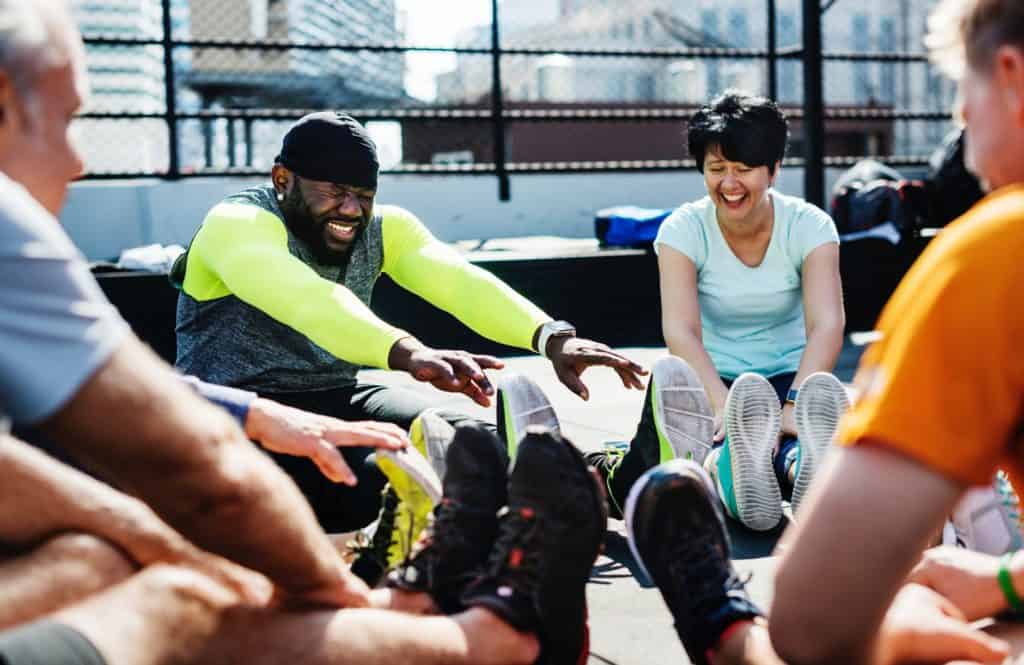Outside Exercise in the Winter?
Seemingly inevitably, the lack of sunlight, especially at higher latitudes, can leave us with the winter blues. The colder months can leave us feeling like we need to be stuck indoors. Take that feeling, fold it up into a nice square, and get rid rid of it. With a few simple precautions, you can easily get back outside and exercising in the depths of winter.
Tip 1: Dress in layers
It’s easy to think that you should always wear one layer of clothing when exercising, but this isn’t the case when it’s cold or windy outside. If you’re only wearing one layer, your body will have trouble staying warm and your muscles will not perform as well.
Instead of just one layer, wear two or three thin layers at once. The extra thickness will help keep moisture away from your skin so that it doesn’t soak through any single item of clothing while helping protect against wind and cold.
Avoid cotton fabrics. Cotton is notorious for being a material that stays wet long after being used. If cotton is wet by snow or sweat, it will stay moist which is terrible when trying to stay warm! I recommend avoiding using any products made from cotton when exercising around year, but especially on days when temperatures dip. Instead, consider investing in moisture wicking materials like wool or polyester.
It’s also important not to overdress because then you’ll lose more heat through convection currents around each body part! Personally, when I run outside I start with shorts and outer pants for my lower extremities and a shirt, thinner long johns, and a hoodie for my upper. Anything more than that and it’s uncomfortable to move in and I actually start to feel colder.
Tip 2: Cover your face, neck, and head
This one should be obvious. When it’s cold out or the wind is blowing, our faces, heads, and necks are extremely susceptible to wind burn or frostbite because they are generally always exposed skin. Therefore, it is smart to cover them with material that will help protect from the elements. Plus, protecting these two vital areas can help keep the rest of you warmer.
Your head is like a chimney. All heat rises to the top, so capping the heat from escaping from the top can help keep it down in your extremities and torso which is always much more comfortable.
If you do not have on a hoodie/coat/outerwear that protects it adequately, consider wearing a scarf or neck gaiter to protect your neck.
Wearing a ski mask or balaclava can feel really weird depending on where you are, but there is no doubt that they will keep your face, neck, and head warm while not inhibiting your ability to breath. Plus, a balaclava can generally be pulled down if your face gets too hot.
Wear a hat. Beanies are awesome for outdoor exercise because they trap heat at the top. Self explanatory.
Sunglasses are also an important part of staying safe in winter weather. They help reduce glare and keep UV rays out of your eyes which is especially important if there is snow on the ground. The extra sunlight bouncing up from the snow layer can be just as blinding as the glare coming through your windshield while driving into the sun during mid summer travels.
Tip 3: Protect your extremities
“Warm up” your extremities by wearing proper gloves, socks, and shoes. The average sock doesn’t always cut it once the temperature dips so consider investing in cold weather running socks if you live in an area where you need to.
Same goes for footwear. Running shoes are usually incredibly breathable which is not a terrible thing… in nice weather. In cold, windy weather that can turn out badly. If cold weather socks don’t cut it, look around for winterized footwear for whatever activity you are performing. There are shoes and boots that block the wind or cold, so whether you are hiking, running, walking, or just out and about, consider changing up your footwear if you need to.
Finally, even when it’s cold out the sun can still burn you. Protect your skin with sunscreen or a long-sleeved shirt that covers most of your arms and legs. This goes back to dressing in layers. Make sure your layers adequately cover your extremities.
Tip 4: Check the weather
You should check the weather before you go out to exercise. The weather can change quickly, especially in winter. Here is a list of what you should look for in the forecast:
- Temperature: This is probably the most important thing to check. Do not exercise if it’s too cold! You could get frostbite or hypothermia if you’re out for too long, which can be fatal in extreme cases. I am not going to tell you what ‘too cold’ is because we all live in different climates, so follow your areas specific guidance.
- Wind Chill Index: The wind speed affects how quickly you increase your risk of hypothermia or frostbite due to direct exposure of air against bare skin surfaces like ears, hands, and face. “Well, you said dress in layers and I’ll be fine, right?” Not always. Wind speed reduces the insulation provided by many types of clothing fabrics that trap dead air between threads! A high enough wind speed will cut right through most layers of clothing, leaving you feeling like you aren’t even wearing extra layers. As always–check this stuff beforehand so there aren’t any surprises later on during workouts!
Need some help?
Shape Success, Live Exceptionally
Hit that button, and get started today.
Tip 5: Assess your surroundings
The winter brings about another set of things you should also consider checking before heading outside to exercise: Safe areas to exercise
If you’re going to be exercising outdoors, it’s important to look for an area where there aren’t any slick or icy surfaces if you are not ice skating. No one wants to be running and slip on some ice. Even if you don’t slip, spending a lot of effort not falling down will negatively impact the quality of your workout.
Downed trees are also a thing in the colder months due to ice, snow, or wind pulling them down, so be aware of that and plan accordingly.
For those of us that live in areas that are a bit more… rural… we also know that, while most animals are more rare in the winter, some animals are breeding in the January-March months which makes them somewhat more dangerous to encounter. If you will be taking trails, plan accordingly and understand the local wildlife system before heading out.
Tip 6: Stay hydrated
You want to keep your body well hydrated. Water is essential for the proper functioning of your muscles, joints and organs. It helps to control your body’s temperature, as well as prevent muscle fatigue during exercise. Winter is, unsurprisingly, a time when there is a massive uptick in dehydration. No one wants to drink some cold water while its cold out and warm/hot water by itself is just nasty.
Force yourself to drink some water before you exercise and continue to do so throughout the duration of your workout. This will help ensure that your body has plenty of fluids available when you need it most – during exercise!
Take a bottle on the go. If you’re thirsty throughout an activity, drink small amounts frequently rather than waiting until after the activity is over or near its end.
Exercising outside during the winter is possible, and can be great for your body.
When we think of exercising in cold temperatures, we tend to picture people bundled up like Michelin men and then stumbling around on snowshoes. That isn’t always the case, but what I hope you take away from this is that not only can you only exercise outside in the winter, it’s great for you!
Cold weather has a ton of amazing benefits for us.
- The colder months have thinner air, so it can actually help your endurance come spring time (at least at first) when the air starts to get a bit thicker.
- Being cold helps us convert our bodies to brown fats instead of white fats, which are actually more insulating and start burning in the cold much easier. Who doesn’t want to be naturally warmer in the winter months?
- Counterintuitively, cold weather exercise can boost our immune response. In fact, it can cut your risk of colds and flu by quite a lot!
Conclusion
There are many options for staying active in the winter. Plan your route, and make sure to dress appropriately.
Get outside and MOVE!
Let Us help You Out
At CONDITIONerd we are here to help you achieve better physical and mental health through exercise. Check out the plans we offer to our customers and see if you could benefit from working with our team. And if you have questions, you can always contact a CONDITIONerd team member.
Personal trainers, like those found here, can help guide you on your pathway towards reaching your fitness goals, whether that is getting bigger, stronger, faster, more lean, or just generally feeling better.
We can get you setup with a periodized workout plan, supplement information, and advice on nutrition to help you reach your goals.
The only thing you need is some motivation and a willingness to change some old habits.
Get into contact with us to find out what membership is right for you. In a CONDITIONerd program, you’ll be surrounded by others who can help you to get where you want to be.
Generally, our clients start to see some pretty awesome changes in 2-3 months time, some sooner.

